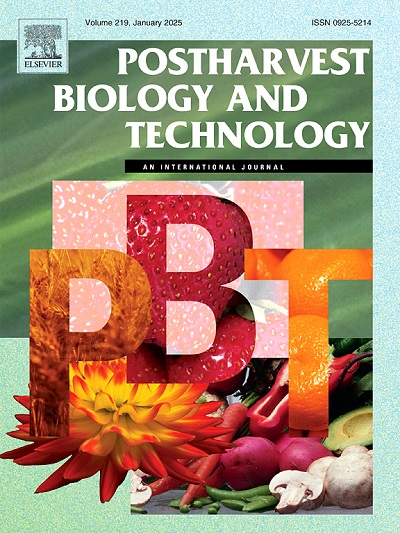生存因子1参与扩张青霉的生长发育、氧化应激反应、展霉素的产生和毒力
IF 6.8
1区 农林科学
Q1 AGRONOMY
引用次数: 0
摘要
膨胀青霉引起蓝霉病,并对采后水果产生有毒的棒曲霉素,造成严重的经济损失和粮食问题。活性氧(ROS)是决定酵母毒力的关键,生存因子1 (Svf1)被鉴定为促进酵母在氧化应激条件下的存活。然而,Svf1是否参与了芽孢杆菌的致病性尚不清楚。本研究在苹果果实中鉴定了一个推测的Pesvf1基因,并通过同源重组构建了该基因ΔPesvf1突变体,分析了该基因在苹果果实中的ROS产生、展霉素积累及其致病性。缺失菌株ΔPesvf1表现出菌丝生长缺陷,侧分支过多,通过下调其生物合成基因减少展曲霉素的产生,并且对诱导内源性ROS产生的氧化应激的敏感性增加。此外,脂质组学发现,当PeSvf1缺失时,脂质代谢重塑,包括积聚的甘油三酯(TAG)、磷脂酰胆碱(PCs)、鞘磷脂(SMs)和磷脂酰乙醇胺(PEs),导致脂滴(ld)的产生,影响细胞膜的完整性和细胞的通透性。ΔPesvf1菌株对富士苹果的毒力明显减弱。总之,我们的研究结果为PeSvf1调控葡萄生长发育、氧化应激反应、脂质代谢、展霉素产生和毒力的机制提供了新的见解,表明PeSvf1有可能成为开发安全的抗真菌底物来控制采后果实中的蓝霉病的目标。本文章由计算机程序翻译,如有差异,请以英文原文为准。
Survival factor 1 contributes to growth development, oxidative stress response, patulin production and virulence in Penicillium expansum
Penicillium expansum causes blue mold disease and produces toxic patulin on postharvest fruits, resulting in serious economic loss and food concerns. Reactive oxygen species (ROS) is critical in determining the virulence of P. expansum, and survival factor 1 (Svf1) is identified to promote yeast survival under oxidative stress conditions. However, whether Svf1 is involved in the pathogenicity of P. expansum remains unclear. In this study, a putative Pesvf1 gene was identified in P. expansum and the ΔPesvf1 mutant was constructed by homologous recombination to analyze ROS production, patulin accumulation and its pathogenicity on apple fruit. The deletion strain ΔPesvf1 showed defective hyphal growth with excessive lateral branching, reduced patulin production by down-regulating its biosynthetic genes, and increased sensitivity to oxidative stress that induced endogenous ROS production. Additionally, lipidomics reveals lipid metabolism remodeling when loss of PeSvf1, including accumulated triacylglycerol (TAG), phosphatidylcholines (PCs), sphingomyelins (SMs) and phosphatidylethanolamines (PEs), that resulting in generation of lipid droplets (LDs) and affecting both the cell membrane integrity and cell permeability. Furthermore, ΔPesvf1 strain exhibited attenuated virulence on Fuji apples. Collectively, our results provided new insights into the mechanisms through which PeSvf1 regulates the growth development, oxidative stress response, lipid metabolism, patulin production and virulence of P. expansum, suggesting a potential of PeSvf1 to be a target of developing safe antifungal substrate to control blue mold in postharvest fruits.
求助全文
通过发布文献求助,成功后即可免费获取论文全文。
去求助
来源期刊

Postharvest Biology and Technology
农林科学-农艺学
CiteScore
12.00
自引率
11.40%
发文量
309
审稿时长
38 days
期刊介绍:
The journal is devoted exclusively to the publication of original papers, review articles and frontiers articles on biological and technological postharvest research. This includes the areas of postharvest storage, treatments and underpinning mechanisms, quality evaluation, packaging, handling and distribution of fresh horticultural crops including fruit, vegetables, flowers and nuts, but excluding grains, seeds and forages.
Papers reporting novel insights from fundamental and interdisciplinary research will be particularly encouraged. These disciplines include systems biology, bioinformatics, entomology, plant physiology, plant pathology, (bio)chemistry, engineering, modelling, and technologies for nondestructive testing.
Manuscripts on fresh food crops that will be further processed after postharvest storage, or on food processes beyond refrigeration, packaging and minimal processing will not be considered.
 求助内容:
求助内容: 应助结果提醒方式:
应助结果提醒方式:


